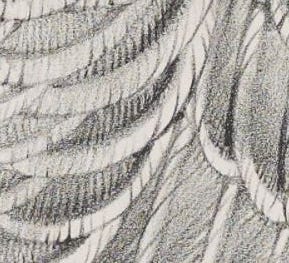Making the Hand-Colored Lithographic Prints in John Gould’s Bird Books
A Step-by-Step Example
By the mid-1800s, lithography had replaced copper engraving as the preferred method for quality book illustration because it was easier and faster (and therefore cheaper) to execute. This shows how the beautiful lithographic prints of birds that illustrate Gould’s books were made.
First, an initial rough sketch was drawn on paper, often by John Gould himself, began the process.
The multiple lines and erasures on this sketch of two Asian ground thrushes (Pitta concinna) reflect Gould’s search for the best composition.
Next, one of Gould’s artists, in this case, William Hart, would develop the sketch into a detailed watercolor painting, which had to be approved by Gould, who insisted on accurate proportions and coloring.
After receiving approval, Hart would then copy the outlines onto tracing paper and blacken the reverse side with a soft lead pencil.
Then, by laying the tracing paper on a block of limestone that had been prepared for lithographic printing, he would retrace the outlines, which would transfer a non-printing guide image onto the printing surface.
Then, following the guidelines, Hart would use a greasy lithographic crayon to draw and shade the bird image onto the lithographic stone.
The stone would have been already rubbed with fine sand and water to give it a velvety texture or grain to which the crayon would adhere.
A close examination with a magnifier would show small irregular dots of crayon adhering to the grained surface of the stone.
At normal reading distance, though, the viewer’s eye blends the tiny dots and perceives them as shades of gray.
Enlarged view of the grained stone surface. Charles Hullmandel, The Art of Drawing on Stone (London, 1824).

Turning the drawing on stone into a printing image was a chemical process. First, the crayon drawing was lightly etched with a gum arabic solution, which adhered to the non-image areas and made the bare stone surface there more water receptive.
The crayon image was then washed out with turpentine, which formed a thin coating on the image, making it receptive to the greasy printing ink.
Next, the printer placed the stone on the bed of a lithographic printing press.
Before inking, the stone was wetted, so the greasy black ink would adhere only to the crayon image.
A blank sheet of paper was then placed on the inked stone and pressed against it by a scraper bar to transfer the black ink onto the paper, forming the printed image.
After the ink had dried, the print was ready to be hand colored with watercolors, by copying a colored master print (called a pattern plate) that had been approved by Gould.
Gould’s colorer was Henry Bayfield, who employed the female members of his family to help with adding watercolor washes by hand to uncolored prints.
The washes not only tinted the black print but also blended visually with the lithographic shading to convey the shape, color, and texture of the feathered bodies of the birds.
Above, the print of a pair of ground thrushes (Pitta concinna) illustrates Gould’s book about the Birds of New Guinea. On the facing page is Gould’s scientific description of the bird, set in metal type and printed by the relief letterpress process.
After being printed separately, the parts of the book were issued in installments to subscribers, who had them bound as volumes once they were complete.
In vogue during the middle decades of the 19th century, such hand-colored lithographic prints of birds were superior in quality to the earlier hand-colored copper-engraved prints they had replaced.
Although they were succeeded in the second half of the 19th century by color-printed chromolithographs, in the early 20th century by four-color process halftone photolithographs, and in the late 20th century by digital images, Gould’s hand-colored lithographic prints are still esteemed as quality bird images.
(Courtesy of Kenneth Spencer Research Library)














